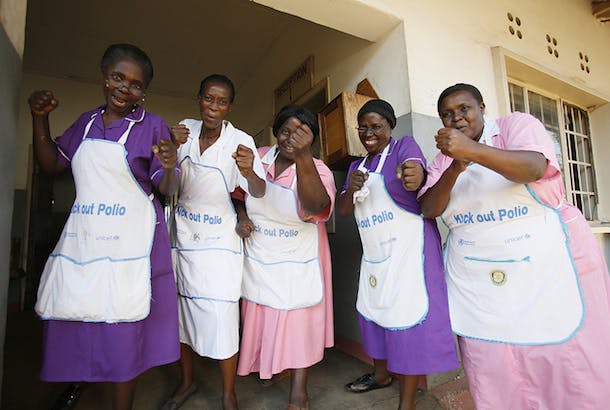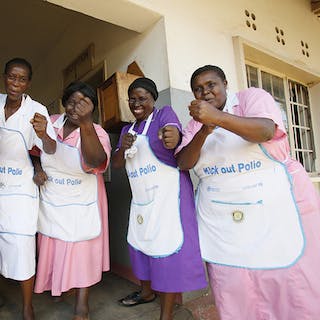 (Photo credit: Stuart Ramson for UN Foundation)
(Photo credit: Stuart Ramson for UN Foundation)
By Ambassador (Ret.) John E. Lange: Senior Fellow, Global Health Diplomacy, United Nations Foundation
February 11 marked six months since the onset of the last confirmed case of wild poliovirus on the African continent. That is longer than at any time in recorded history. There is now a chance that we are on the verge of a historic achievement in global health: an Africa free of wild poliovirus.
The devastating Ebola outbreak in West Africa, combined with a surge in the number of polio cases in Pakistan in 2014, have diverted attention from this potential accomplishment. As of February 11 (with results still coming in), there were only 22 wild poliovirus cases on the continent during 2014 (a drop of over 90% from the year before). Only six wild poliovirus cases were reported in 2014 in Nigeria, the last remaining polio-endemic country in Africa, and the most recent case on the continent was discovered in Somalia on August 11. Leaders of the Global Polio Eradication Initiative (GPEI) are optimistic that a polio-free Africa is in sight.
The history of the global effort to stop polio transmission, which has suffered many ups and downs since the World Health Assembly established the eradication goal in 1988, dictates caution in any such projection. For example, the Ebola outbreak understandably led to the postponement of supplementary polio immunization activities in Liberia, Guinea and Sierra Leone, and the quality of acute flaccid paralysis surveillance – an indicator of possible polio — markedly decreased in those countries. Also, there are certain areas that are inaccessible in Nigeria as well as in Somalia. Nevertheless, even if new cases were to appear on the continent, there is no doubt that prospects for the eradication of polio in Africa are better than ever.
The African Union (AU) and its member states continue to play critical roles in this endeavor. In July 1996, the Organization of African Unity (the predecessor to the AU) held its Summit meeting in Cameroon, where African leaders unanimously adopted the “Yaoundé Declaration” to eradicate polio from all of Africa and to protect every child from this debilitating disease. Over the years, African governments, supported by the international community, have waged an intense battle against the disease.
But everyone recognizes there is no room for complacency. African Union First Ladies met in Addis Ababa on January 31 and called for continent-wide efforts, leadership and political commitment to kick polio out of Africa. They agreed to advocate for a polio-free Africa as a top priority for their governments in 2015 and pledged to engage in heightened advocacy and personal participation in supplementary immunization and accelerated routine immunization activities, such as African Vaccination Week, which will take place April 24-30, 2015.
The few countries that had polio cases earlier in 2014 need to sustain their momentum and ensure high-level oversight, while all countries need to be vigilant and ensure they implement effective programs for immunization and surveillance. This effort will have the added benefit of using the extensive polio infrastructure to help strengthen other immunization and primary healthcare programs that can grow and thrive after polio is eradicated. The United Nations and the broad group of stakeholders in the global polio eradication program will continue to support Africa in this endeavor.
On my visit to Cameroon with GPEI partners a few months ago, the progress and the challenges of polio eradication were apparent. Our delegation included the leaders of the polio programs at the World Health Organization (WHO), UNICEF and the U.S. Centers for Disease Control and Prevention as well as a senior officer from the Bill & Melinda Gates Foundation and the local representative of Rotary International. As one who regularly engages in discussions of polio at WHO headquarters and other global health venues, I found it quite gratifying to vaccinate children myself during Cameroon’s national immunization days against polio in October.
Cameroon, with five wild poliovirus cases in 2014 (most recently in July), is one of four countries deemed to be currently exporting wild poliovirus. As a result, WHO asked the government to ensure that all residents and long-term visitors receive a dose of polio vaccine before traveling internationally. The Central African region poses a distinct threat to eradication efforts due to low levels of immunity in the population, poor disease surveillance, population movements across borders, low quality immunization programs and conflict and insecurity. GPEI is working with governments in the region to address those challenges.
The President of Cameroon has personally supported the polio campaigns. Our delegation met in Yaoundé with the Prime Minister, the Minister of Public Health and other top government officials, all of whom expressed their personal commitment as well as the government’s commitment to stopping polio transmission. Such high-level political support coupled with close oversight is crucial for the success of the campaigns.
But political will is not sufficient to reach the goal. In the end, every child needs to be reached and vaccinated. So we also observed immunization activities in Yaoundé, Bafia and other areas of central Cameroon. In addition to oral polio vaccine, the house-to house campaign provided vitamin A drops and deworming tablets to the children.
Our conclusion: the quality of polio campaigns has improved in a number of ways since the outbreak was first confirmed over a year ago, though more needs to be done to reach missed children. With high-level governmental oversight of the outbreak response efforts and a “whole of government” approach to reaching and vaccinating every child (including in refugee camps), we are confident the country will be polio-free. And we strongly support longer-term efforts to improve health, and to keep Cameroon from being re-infected, by increasing the levels of routine immunization and strengthening the health system.
Polio is a debilitating, paralyzing and incurable disease that is easily preventable through vaccination. Yet ending polio is an extremely difficult endeavor. Unlike other large-scale global health programs, an eradication program fails to achieve its objective if there is even one case anywhere in the world. GPEI is close to reaching its goal: the number of polio cases dropped from 350,000 a year in 1988 to a historic low of 223 in 2012 and 358 in 2014 (over a 99% reduction in the global incidence of polio). But much more will need to be done to finish the job, particularly in Pakistan. And GPEI faces challenges related to introducing inactivated polio vaccine (which is administered through injections) in many countries and stopping the rare circulating vaccine-derived poliovirus.
The effort to end polio in Africa (and around the world) needs to remain a top priority on the global health agenda. We’re closer than ever to achieving the historic vision of the Yaoundé Declaration.
John E. Lange serves as the Co-Chair of the Polio Partners Group of the Global Polio Eradication Initiative.

